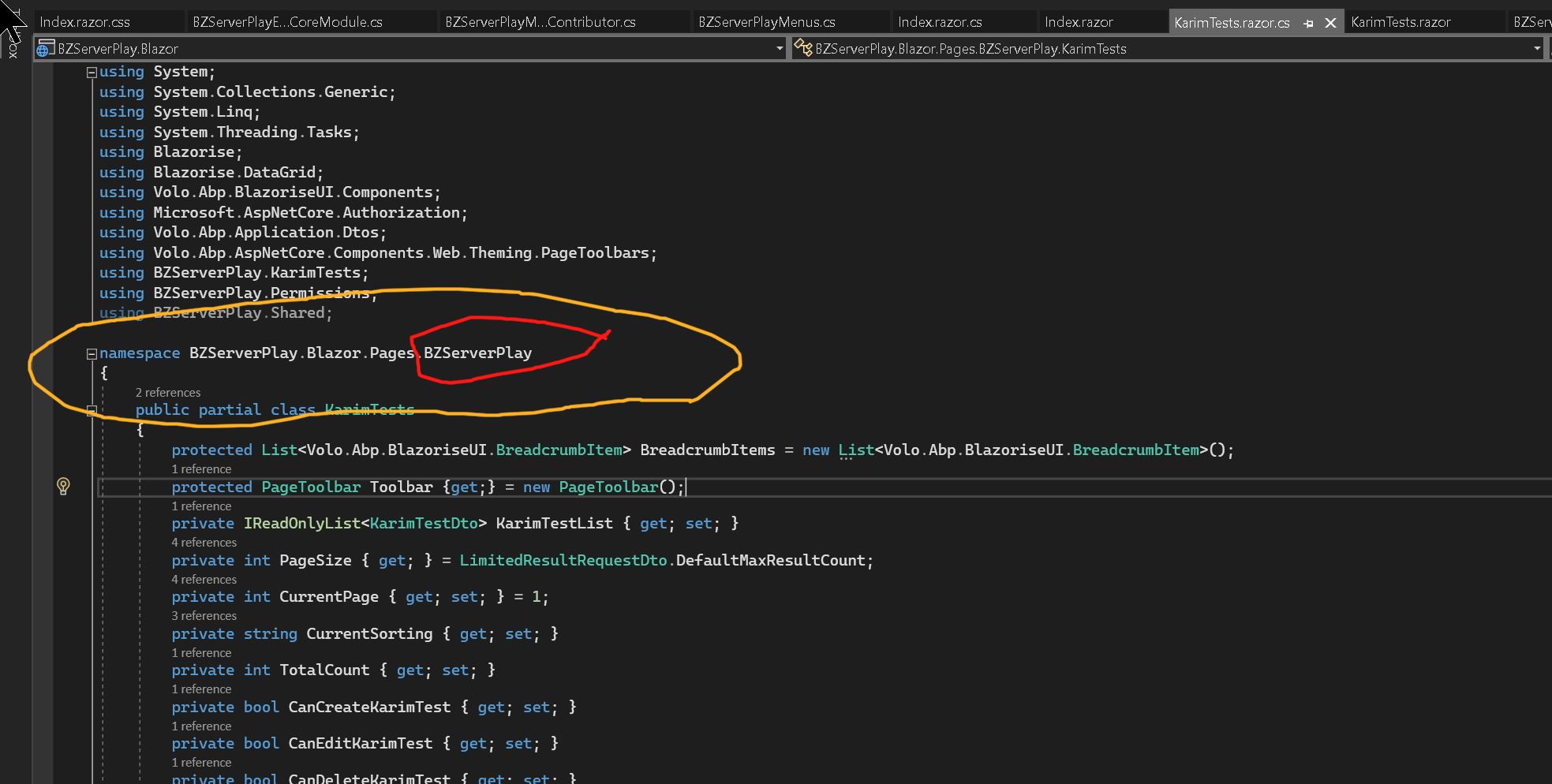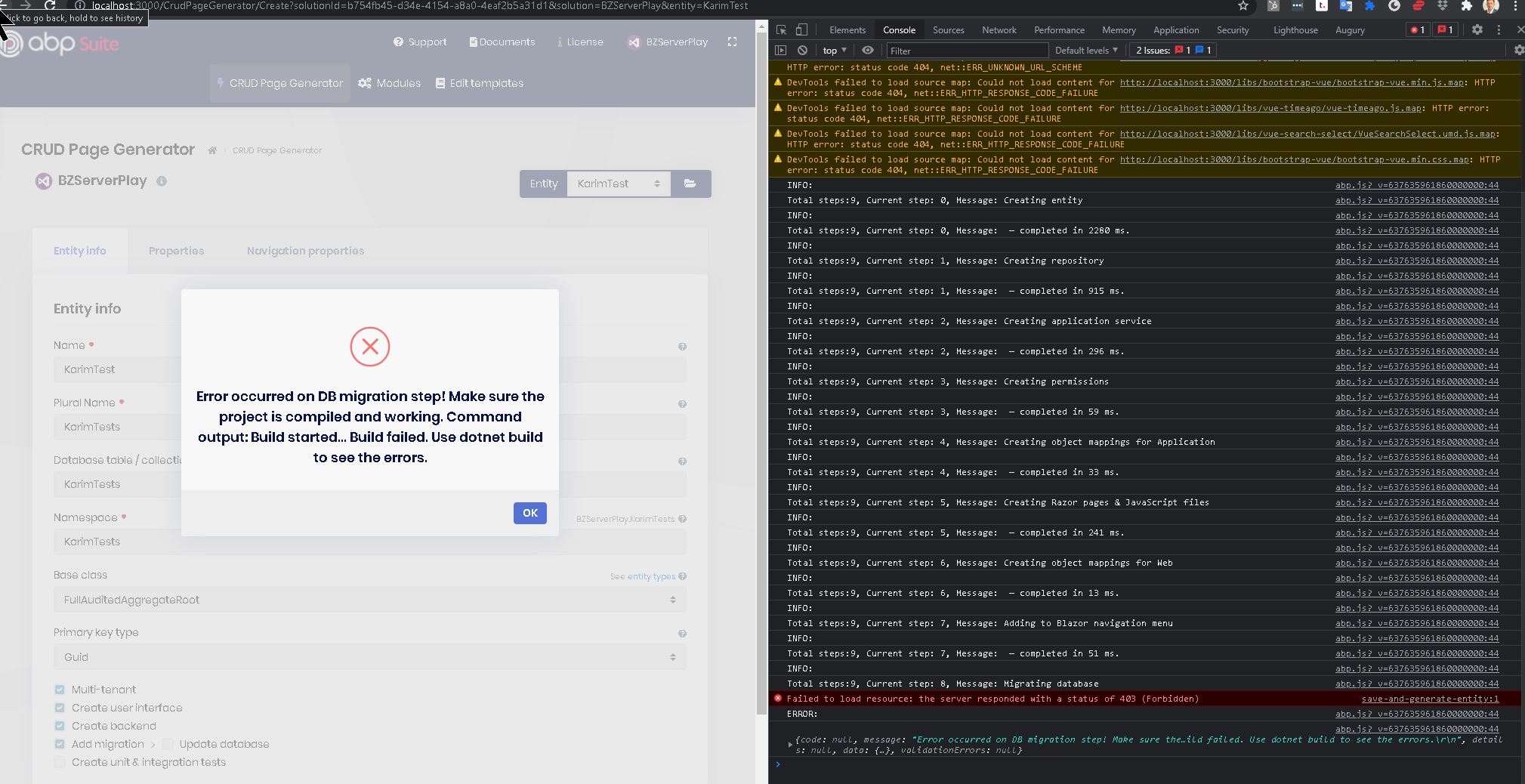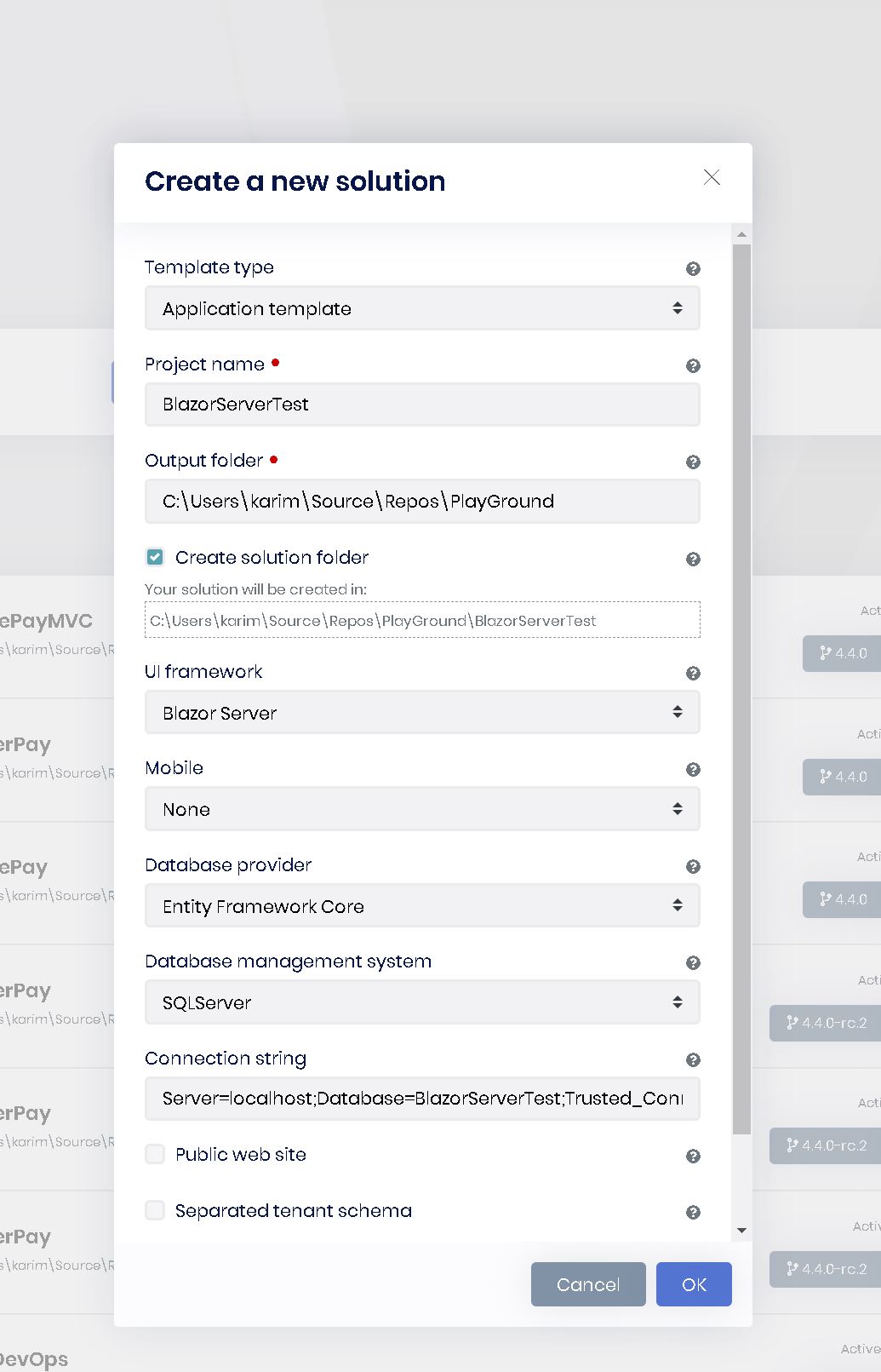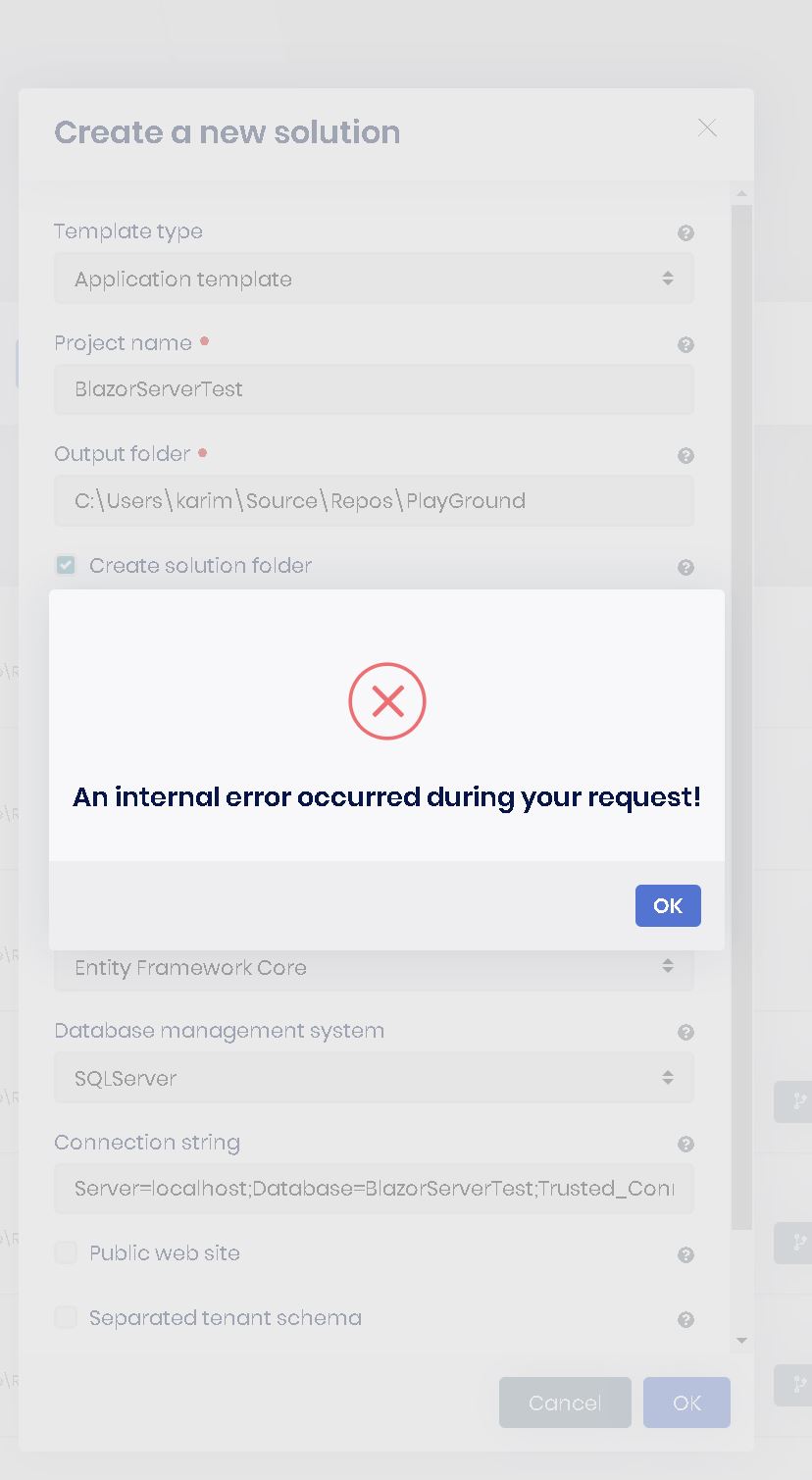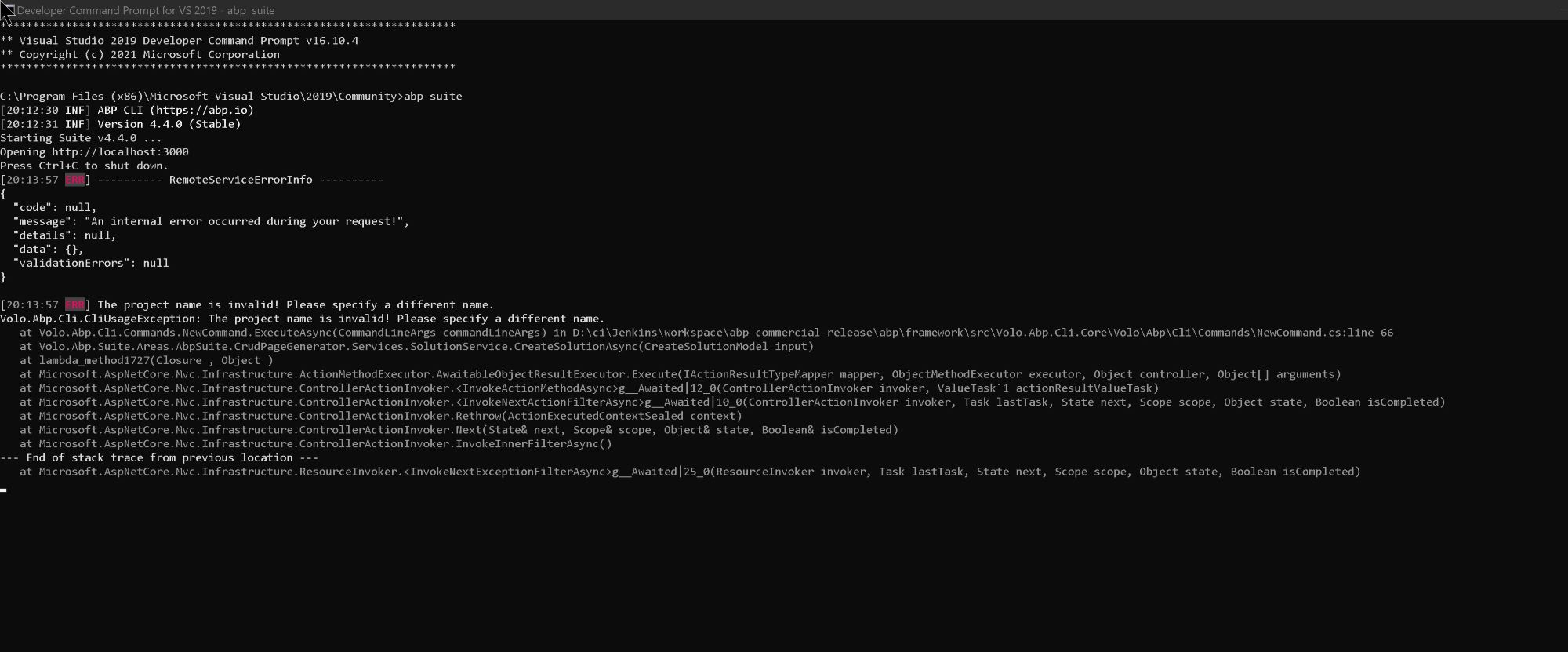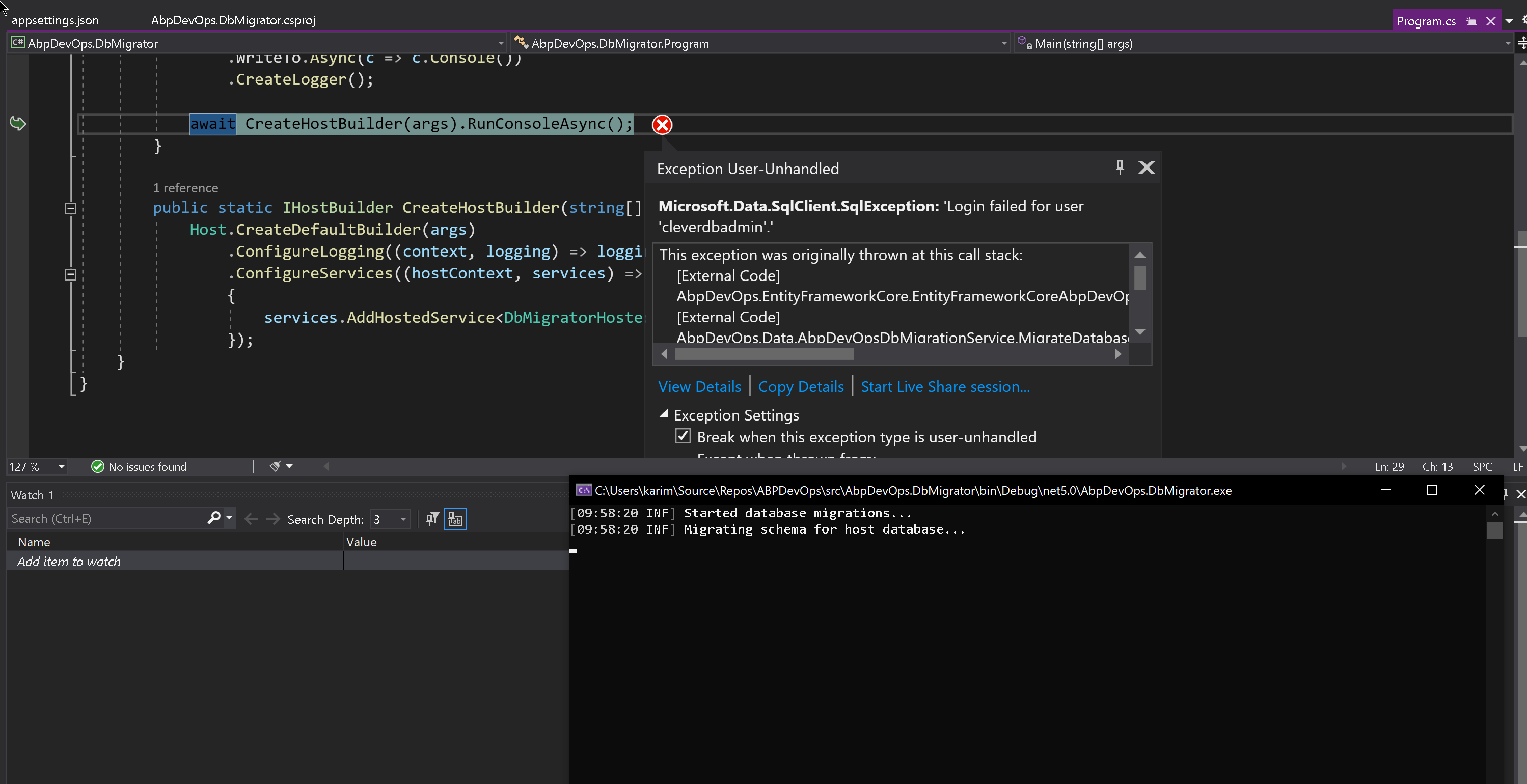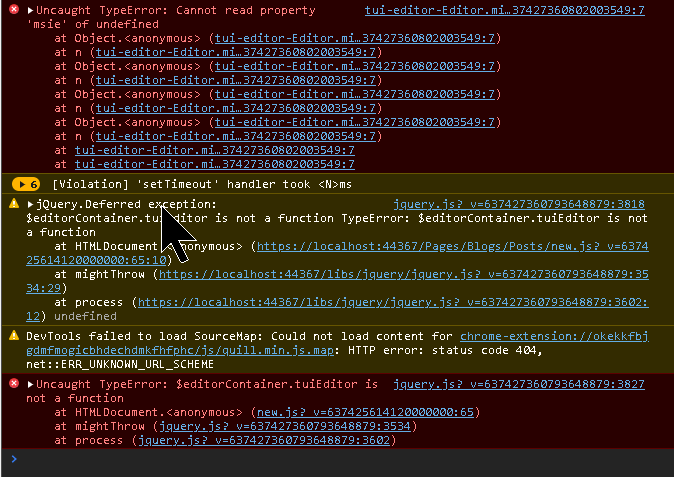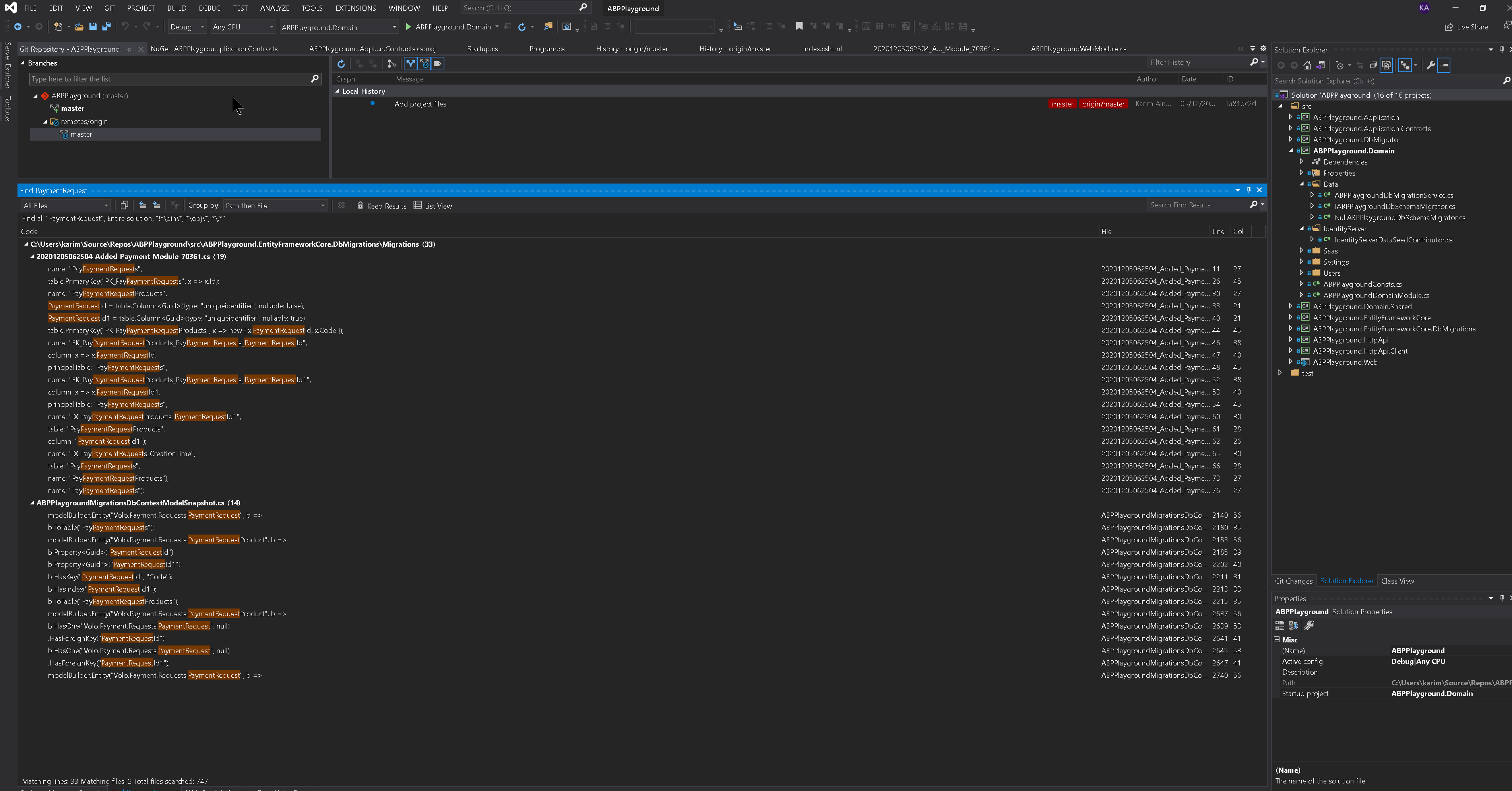Activities of "okains"
Hi,
Yes, I figured that out after experimenting a few times and just settled on using BZ instead. However 'Blazor' is and should be allowed in project names. If you look at a lot of the online tutorials / documentation they use Blazor in the project name extensively. Is there a reason why you decided to make it invalid in this case?
I am having problems generating an entity with ABP Suite. For me, the project name 'BZServerPlay' is appended to the namespace of the razor file for all ABP Suite generated entities. This causes the build to fail at the point of DB Migration. When I remove the extra .BZServerPlay namespace then everything builds with no problems. Please see the attached screenshots for more details.
The work around is to generate as is, with the exception thrown. Then modify the namespace by removing the last .BZServerPlay from the generated namespace of 'BZServerPlay.Blazor.Pages.BZServerPlay'. , then generate without UI. Then everything works as expected.
But this can only be temporary! Please let me know what the situation is here, if this is a bug please let me know when fixed.
Thanks,
Karim
Check the docs before asking a question: https://docs.abp.io/en/commercial/latest/ Check the samples, to see the basic tasks: https://docs.abp.io/en/commercial/latest/samples/index The exact solution to your question may have been answered before, please use the search on the homepage.
If you're creating a bug/problem report, please include followings:
- ABP Framework version: v4.4.0
- UI type: Blazor
- DB provider: EF Core
- Tiered (MVC) or Identity Server Separated (Angular): no
- Exception message and stack trace: image attached
- Steps to reproduce the issue:"
It seems that you added this validation in 4.4 :
https://github.com/abpframework/abp/issues/8959
and I am guessing you are validating out the keyword 'Blazor' for project names? When I changed from Blazor, to 'BZ' then the project was created.
I can create a project using VS with the keyword 'Blazor' in the project name. This took longer than it should have to work through, can you confirm that this is a bug in your code or if I have missed something?
Thanks,
Karim
I am trying to create a Blazor Server project using ABP Suite. I consistently get Project Name Invalid Errors, and have tried different project names but still the same error.
I have attached screenshots of my input, and also of the exception thrown by the CLI. Can you let me know if this is a bug or if I am doing something wrong? Need to get this project created as soon as possible.
Thanks,
Karim
Check the docs before asking a question: https://docs.abp.io/en/commercial/latest/ Check the samples, to see the basic tasks: https://docs.abp.io/en/commercial/latest/samples/index The exact solution to your question may have been answered before, please use the search on the homepage.
If you're creating a bug/problem report, please include followings:
- ABP Framework version: v4.4.0
- UI type: Blazor
- DB provider: EF Core
- Tiered (MVC) or Identity Server Separated (Angular): no
- Exception message and stack trace: attached
- Steps to reproduce the issue:"
OK, as mentioned in my question, and in my response:
As mentioned in my question, the credentials are correct. I can connect to the azure DB using SQL Enterprise Manager, remotely from my pc, with no issues.
This is the same user account that I am using to connect to the azure db using SQL Enterprise Manager, locally. So I know the credentials are correct, the firewall port is open and Azure has whitelisted my IP address.
So the user has permissions. Is there anything else that I am missing here that would prevent me from running the migrator locally to see this remote azure db?
Would this best handled in a DevOps pipeline? I was thinking that I could just quickly run the DBMigrator project with the remote connection string and be done with it.
Hi,
Double check what? My username / password?
As mentioned in my question, the credentials are correct. I can connect to the azure DB using SQL Enterprise Manager, remotely from my pc, with no issues.
This is the same user account that I am using to connect to the azure db using SQL Enterprise Manager, locally. So I know the credentials are correct, the firewall port is open and Azure has whitelisted my IP address.
Is there more config that I need for this? Maybe the connection string isn't set correctly? I have set the connection string in appsettings.json as follows:
"ConnectionStrings": { // "Default": "Server=localhost;Database=AbpDevOps;Trusted_Connection=True", "Default": "Server=tcp:clevermm.database.windows.net,1433;Initial Catalog=AbpDevOps;Persist Security Info=False;User ID=XXXXXXXX;Password=XXXXXXXX;MultipleActiveResultSets=False;Encrypt=True;TrustServerCertificate=False;Connection Timeout=30;"
Here is a screenshot of the exception:
I have tried running DBMigrator with the correct connection string to my azure sql db. However I get a login failed for user xxxxxxx error. This is the same user account that I am using to connect to the azure db using SQL Enterprise Manager, locally. So I know the credentials are correct, the firewall port is open and Azure has whitelisted my IP address.
Any ideas on how to get this to work for the initial seed?
Thanks,
Karim
Check the docs before asking a question: https://docs.abp.io/en/commercial/latest/ Check the samples, to see the basic tasks: https://docs.abp.io/en/commercial/latest/samples/index The exact solution to your question may have been answered before, please use the search on the homepage.
- ABP Framework version: v4.0.1
- UI type: MVC
- DB provider: EF Core
- Tiered (MVC) or Identity Server Seperated (Angular): no
- Exception message and stack trace:
- Steps to reproduce the issue:
<br> <br> My last question, regarding the Payment module, could have been avoided if you had proper documentation, including expected use-cases with sample code. I am now planning on implementing the Blog Module and there is no documentation at all, just a TODO. So what to do? Well, I searched support and found another question about Blogs, posted recently, that included the fact that the blogs were at /blogs/{NAME} . Ah, great, now I can go that page, create a new post, but I get the JS error below.
This is the only complaint that I have with ABP: The module documentation doesn't go far enough in depth. Not even close. Going back to the Payment module question that I posted previously, there were so many follow ups that I had to ask, and even then your architecture for that Module was not fully explained, so I gave up (until now!).
I know you are amazing developers and software architects. That is why I paid for the commercial license, because your code is great and you obviously know what you are doing. I have both managed and been a part of high end development teams, and I understand that we all would rather spend time working on new code than documenting what is there already, as of course it is 'easy to understand and makes sense' (because you / we wrote it!).
However the X amount of hours it might take your lead module developer to fully document a module, versus the 8000 total hours that it might save your customers should be a priority. We pay for the commercial license because we can see a list of all these amazing features. When we get to the point of implementation, check the docs and see a page of incomplete documentation, or worse, a TODO, and realise that now we need to invest hours / days of our time investigating your libraries and asking questions like this on your premium support then it makes us question the value of our purchase.
Also, we have a certain number of premium support tickets available per year. These should be used to ask proper questions when we have significant issues where there is a bug / blocker type situation. Having to spend our premium support tickets on basic questions that should be covered in documentation both frustrates you and us.
The rest of your documentation is quite good, especially the Web Application Development Tutorials. I would ask that you provide the same level of documentation for your Modules as soon as possible.
Thanks,
Karim
OK, after spending some time reviewing your answer and digging into the namespaces around Payment I am starting to better understand how this module works. I can now inject the service, and I can see how the Gateway Page works and I can see the rest of the payment infrastructure.
I think fundamentally though that the documentation is not great, and it has taken more time than it should for me to get up to speed with how this works. I suggest that you provide in depth documentation for the Payment module, and probably for all modules, so that us, as your customers, can spend less time figuring out your infrastructure and more time on our projects.
I have 2 more questions around this then we can close out. First of all, the 2Checkout documentation lists a certain set of params in the json configuration. I have supplied all of these, yet I still get an error:
' ArgumentException: Two checkout extra parameters are not configured for this product !' error.
Here is my JSON config for payment, the 'XXXXXXXX--MYSIGHERE--XXXXXXXX' param is replace with a valid 2Checkout signature.
*
"Payment": {
"Payu": {
"Merchant": "TEST",
"Signature": "SECRETKEY",
"LanguageCode": "en",
"CurrencyCode": "USD",
"VatRate": "0",
"PriceType": "GROSS",
"Shipping": "0",
"Installment": "1",
"TestOrder": "1",
"Debug": "1"
},
"TwoCheckout": {
"Signature": "XXXXXXXX--MYSIGHERE--XXXXXXXX",
"CheckoutUrl": "https://secure.2checkout.com/order/checkout.php",
"LanguageCode": "en",
"CurrencyCode": "USD",
"TestOrder": "1"
},
"PayPal": {
"ClientId": "CLIENTID",
"Secret": "SECRET",
"CurrencyCode": "USD",
"Environment": "Sandbox",
"Locale": "enUS"
},
"Stripe": {
"PublishableKey": "PUBLISHABLEKEY",
"SecretKey": "SECRET_KEY",
"PaymentMethodTypes": [ "alipay" ]
}
}*
Second, I will be using a 3rd party gateway and I would like to know how to set this up correctly. There is no documentation that describes how to do this. In your documentation you state the following:
PaymentOptions is used to store list of payment gateways. You don't have to configure this manually for existing payment gateways. You can, however, add a new gateway like below:
Configure<PaymentOptions>(options => { options.Gateways.Add( new PaymentGatewayConfiguration( "MyPaymentGatewayName", new FixedLocalizableString("MyPaymentGatewayName"), typeof(MyPaymentGateway) ) ); });
What is MyPaymentGateway? Can you provide an example of this, along with any supporting classes or DTOs that I would need to configure a new payment gateway? I am sure that I am not the only person having trouble with this, I suggest updating your documentation to cover these common use cases and provide us, the end user, with functional examples of how to get things done.
Thanks for your help,
Karim
I don't understand. In the documentation it clearly states that there is a PaymentRequest object, also a PaymentRequestAppService, and a PaymentRequestRepository. None of these are created when I install the module. As you can see from the screenshot below the only thing related to 'PaymentRequest' are the migrations, which work fine. Other than that there is nothing, no Payment Gateway Selection UI, no admin menu options, nothing.
So what I am saying is that these required files are not being created on add-module. I understand about configuring the payment gateways in appsettings.json, that is fine. But what about all of the supporting files and UI?
Can you let me know if this is a bug, or if there are other steps that I need to take?
